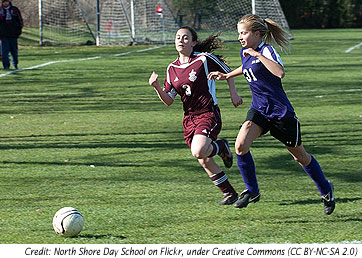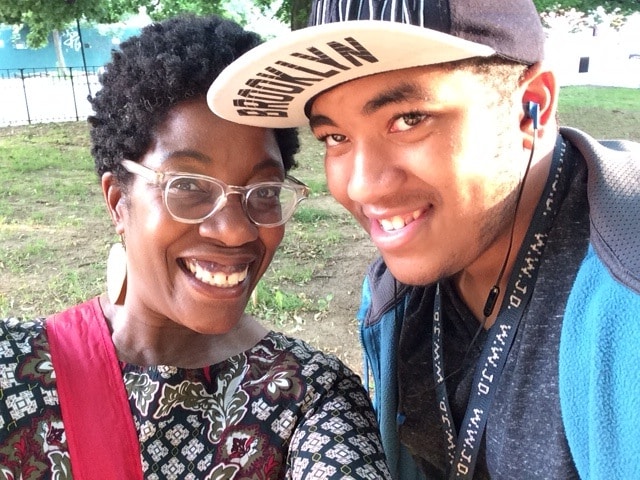
(Publisher’s note: On March 8, join Women’s eNews at our offices for a 40th celebration of Title IX with New York Liberty legend Kym Hampton, Joanne Smith, executive director of Girls for Gender Equity, and more. The panel discussion takes place on March 8, at 6:30 p.m., at 6 Barclay St., 6th Floor, New York NY 10007. Register here.)
 (WOMENSENEWS)–Title IX, the gender-equity law for schools that turns 40 this year, has plenty to show for itself in gyms and playing fields where young women are shooting hoops, scoring goals and getting plenty of press.
(WOMENSENEWS)–Title IX, the gender-equity law for schools that turns 40 this year, has plenty to show for itself in gyms and playing fields where young women are shooting hoops, scoring goals and getting plenty of press.
But beyond the reach of Title IX–in the professional arena outside school–it’s a whole different game.
ESPN’s SportsCenter–a major hub for mainstream sports fans–provides an indication. Only 1.4 percent of coverage there in 2009 went to women’s sports, down from 2.2 percent in 1999, according to the Center for Feminist Research.
An analysis of intercollegiate athletic websites finds women’s sports winning far more attention by campus media. Female players are most neglected by multimedia technology, where they claim only about 22 percent of audio and video coverage. Otherwise, however, women’s sports command about 40 percent of article and photo coverage.
Kym Hampton, a former WNBA player who spent three years with New York Liberty, doesn’t blame the sports media for overlooking women.
Sports coverage is tied to fans, Hampton says, and those fans start young. Families and teams take more boys to the bleachers and stadiums. "They’re seeing it, they’re watching it. They’re students of the game."
Girls might be playing more basketball–feeling the pressure of the shot clock or savoring an unexpected win–but they aren’t encouraged to become fans of professional teams.
Hampton doubts women’s sports coverage will improve until more women–even those not interested in sports–start going to sporting events in greater numbers. "We have to do that for each other."
For women’s professional sports to be viable, tickets must be sold, says Hampton. "The bottom line is dollars."
At the end of the WNBA season last year, only three of the basketball league’s 12 teams had made a profit. Women’s Professional Soccer, only a few years old, recently announced that it would not have a 2012 season as it battles a legal case with a team owner. A women’s professional softball league, National Pro Fastpitch, was created in 1997, folded in 2001 and restarted in 2004. The league has four teams.
The ailing condition of women’s pro sports stands in night-and-day contrast to school sports.
Three million young women participated in high schools sports teams last year, according to the National Federation of State High School Associations. That’s a huge leap from 300,000 in 1972, before the passage of Title IX, which bars public schools and colleges that receive federal funding from discriminating on the basis of sex.
And college women scored big too–185,000 players in 2009-10, according to the National Collegiate Athletic Association–way up from 30,000 in 1972.
Despite its transformation of school sports, many — including school administrators — don’t know what Title IX is.
Joanne Smith is executive director of Girls for Gender Equity, a New York nonprofit. She contacted 200 New York City public schools in order to find the names of their Title IX coordinators, the people to whom students would turn if they felt they had suffered discrimination. Few school officials knew what Title IX was.
"There’s still a gap, a lack of recognition and understanding of federal policy as a law and as a right," Smith said.
She finds that Title IX is poorly implemented, especially in matters other than sports, such as sexual harassment and gender violence in schools. "It’s a real educational moment…when we talk about Title IX and sexual harassment," says Smith.
Would you like to Comment but not sure how? Visit our help page at https://womensenews.org/help-making-comments-womens-enews-stories.
Would you like to Send Along a Link of This Story?
https://womensenews.org/story/athleticssports/120304/womens-school-sports-beat-pros-long-shot
Samantha Kimmey is a writer based in Brooklyn, N.Y.
For more information:
National Collegiate Athletic Association:
http://www.ncaa.org/wps/wcm/connect/public/NCAA/Resources/Latest+News/2010+news+stories/December/Participation+rate+climbs+to+430,000+student-athletes
Girls for Gender Equity:
http://www.ggenyc.org/


